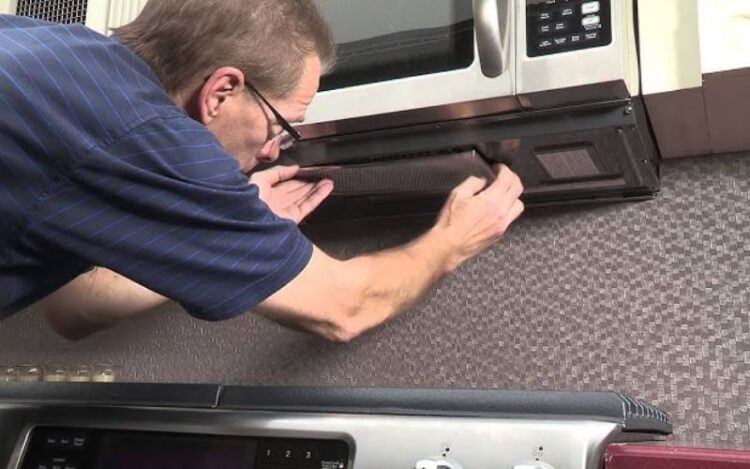The microwave oven’s unrivaled ease of use in modern kitchens has made it a must-have gadget for those who often use it to reheat food. Many people who own microwaves, however, neglect to clean the microwave filter. Reduced microwave efficiency, unpleasant odors, and even safety issues might result from ignoring this essential part. In this detailed tutorial, you’ll learn why it’s crucial to maintain a clean microwave filter and how to do it in a way that won’t damage your appliance.
Types and Use of Filters in Microwaves
Filters in microwaves are essential to the devices’ continued operation. There are a few different kinds of filters, the most common of which are:
Microwaves generate grease, oils, and food particles that can be filtered out by a grease filter composed of metal or mesh. They stop the buildup of such contaminants on the inside parts, making for a healthier and safer kitchen.
Activated carbon charcoal filters do a fantastic job of cleaning the air within the microwave of unpleasant odors and other contaminants. Particularly helpful for preventing the spread of off-putting aromas when reheating highly flavored or spiced foods.
Recognizing the importance of routine cleaning and maintenance for your microwave requires an understanding of the function of these filters.
Step-by-Step Guide on How to Clean a Microwave Filter
Removing the Filter
If you want to be safe while cleaning your microwave, you should start by disconnecting it from the power source or turning off the breaker.
To access the filter, look for a removable grille or cover on the microwave’s bottom or rear. If you are unsure how to use your microwave, please refer to the instruction booklet.
Follow the manufacturer’s directions for removing the filter with care. Filters may be unscrewed from their housings or slipped out of some models.
After taking it out, check the filter for any debris like dust or grease that might have accumulated.
Filter Cleaning Without Chemicals
Make of Water and Soap
A simple solution of warm water and mild dish soap can be very efficient for regular cleaning:
Put a few drops of mild dish soap into a basin or sink full of warm water.
Soak the filter for 5-10 minutes in the soapy water.
To clean the filter, use a soft brush or sponge to scrub away grime and grease.
Rinse under running water until there is no trace of soap left. d.
The filter must be entirely air dried before being reinstalled, thus e.
Use Lemon Juice or Vinegar
Natural acids, such as lemon juice or white vinegar, can be used to remove odors and stains that just won’t go away.
Mix equal parts water and lemon juice or white vinegar.
Soak the filter in this mixture for 15 to 20 minutes.
Brush or sponge the filter softly to clean it.
Wash it thoroughly in running water and let it dry naturally.
Utilize Baking Soda
Baking soda is quite effective at eliminating odors and removing stubborn stains:
Combine baking soda and a tiny bit of water to form a paste.
Spot-treat stained parts of the filter with the paste. b.
Leave it alone for 10 to 15 minutes.
Rinse with running water after a light scrubbing.
Let the filter dry completely in the air.
Chemical Detergents for Persistent Messes
Extreme occurrences of grease or dirt buildup may require the use of chemical cleaners that are safe for use in microwaves. However, take care when handling chemicals and make sure the room has plenty of ventilation.
Reinstalling the Filter After Cleaning
Before replacing the filter in your microwave after cleaning, double-check that it is totally dry. To ensure a successful reinstallation, be sure to consult the manufacturer’s guidelines. After you’ve replaced the filter, you can power up your microwave again.
Advice for Keeping Your Microwave’s Filter Clean and Safe
Turn Off the Power Supply Before Working on It
Maintaining your microwave requires careful attention to safety precautions. Make sure the microwave is unplugged or the circuit breaker is switched off before cleaning or removing the filter. As a result, you won’t have to worry about getting shocked or accidentally turning on the device.
Wear Protective Gear When Working with Chemicals
Wear protective gear if you decide to use chemical cleaners on tough stains. To prevent skin and eye irritation, protective gear such as gloves and safety goggles should be worn. Also, make sure the area has adequate ventilation to get rid of any lingering odors.
Conclusion
What You Need to Know About Cleaning Your Microwave Filter
To keep your microwave running smoothly and for as long as possible, it’s important to regularly clean the filter. In conclusion:
To begin, turn off the electricity to ensure nobody gets hurt.
Find the filter and take it off.
Make use of soap and water, some lemon juice or vinegar, or some baking soda to clean the filter the natural way.
Sticky messes can be cleaned with chemical cleaners that are safe to use in the microwave, but only if precautions are taken.
The filter must be washed and dried completely in the open air.
The filter must be reinstalled in a specific way specified by the manufacturer.
Disconnect the power cord and start using the microwave again normally.
Suggestions for Future Maintenance Cost Cuts
Take these precautions to reduce the frequency of filter cleaning and maintenance:
To avoid messy splatters, cover your food.
Cover or cap microwave-safe containers to keep steam and smells in.
To avoid buildup, wipe out the microwave’s interior on a regular basis.
To prevent unpleasant smells and grease buildup, be selective about the items you reheat in the microwave.
If you follow the steps in this tutorial and take precautions, you may keep your microwave running smoothly, safely, and without any unpleasant odors for many years to come. In addition to extending the life of your microwave, routine servicing also helps to keep your kitchen cleaner and safer for cooking.

